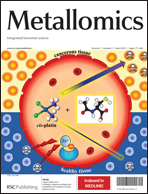Ruthenium(ii) polypyridyl complexes as G-quadruplex inducing and stabilizing ligands in telomeric DNA
Abstract
Two ruthenium(II) polypyridyl complexes [Ru(phen)2(4idip)](ClO4)2 (1) and [Ru(bpy)2(4idip)](ClO4)2 (2) (phen = 1,10-phenanthroline, bpy = 2,2′-bipyridine, 4idip = 4-indoleimidazo[4,5-f][1,10]phenanthroline) designed as telomeric G-quadruplex ligands have been synthesized and characterized. The interaction of human telomeric G-quadruplex DNA (HTG21) with the designed ligands was explored by fluorescence analysis, absorption spectroscopy, continuous variation, circular dichroism spectroscopy, fluorescence resonance energy transfer (FRET) melting assay, polymerase chain reaction (PCR) stop assay, telomerase repeat amplification protocol (TRAP), and visual studies. The results showed that both complexes could induce and stabilize different G-quadruplex structures by using a 1 : 1 [quadruplex]/[complex] binding mode ratio. Complex 1 exhibited higher interaction ability and better G-quadruplex selectivity than duplex DNA. Furthermore, both ruthenium complexes led to the inhibition of the enzyme telomerase, and complex 1 was the significantly better inhibitor.


 Please wait while we load your content...
Please wait while we load your content...